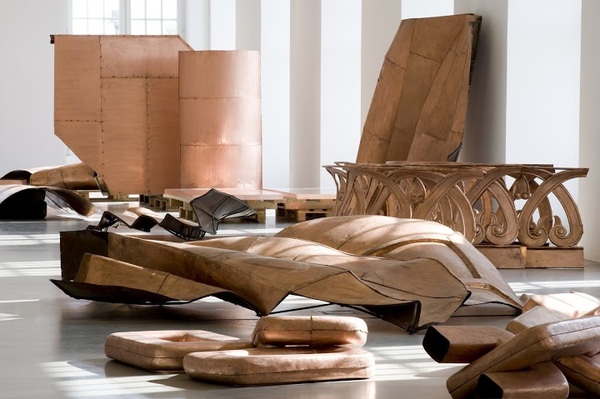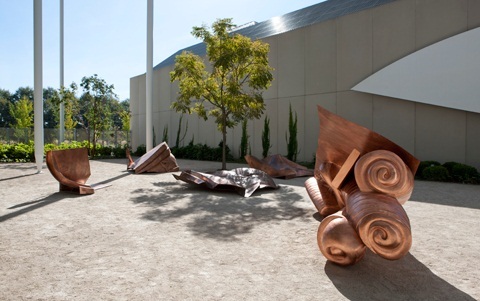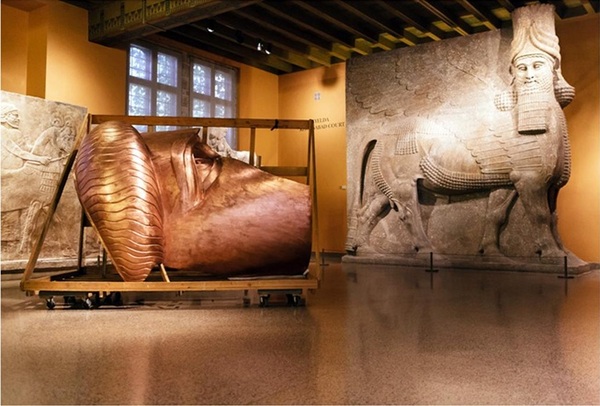Chicago, Dec. 2012: Danh Vo, a Danish, Vietnamese-born artist living in Berlin, won the Guggenheim Foundation’s Hugo Boss Prize this year. His work combines a nuanced approach to relations existent within the conventions of the art world as well as the relationships that are developed with objects, both personal and foreign, in the negotiation of identity. In short, Vo’s ability to imbue otherwise mundane objects with a delicate, sublime sentimentality is what makes this young artist worth watching.
Vo’s background reads like…well, nothing I’ve ever read before. At the age of four, his family was forced to flea South Vietnam in a handmade boat that was rescued by a Danish freighter, which took them to Denmark, where he would grow up.
We spoke of his current exhibitions on view at the Art Institute of Chicago and the Renaissance Society as well as the role of the object in his artistic practice.

Exhibition view of Danh Vo's "July IV, MDCCLXXVI," Kunsthalle Fridericianum, Kassel, 2011; Photo by Nils Klinger.
Joel Kuennen: Uterus, as well as some of your previous gallery installations, consists of disparate objects placed in relational groupings that are then placed in isolation around the gallery space. The effect on the viewer is a meditative contemplation on each constellation. How do you see the space between installations as affecting each grouping? What roles do space and context play in your art practice?
Danh Vo: Each exhibition presents different sets of circumstances, but I don’t have one logic or method I follow each time. I negotiate these circumstances differently; approaching the arrangement of objects has to do as much with conceptual reasoning—or rather how to get avoid conventional conceptual reasoning—as it does with more frivolous and unpredictable things, such as my mood or something I find seductive at a given time.
JK: Duchamp, when asked why he chose the objects he did for his readymades, responded that “this choice was based on a reaction of visual indifference with at the same time a total absence of good or bad taste … In fact a complete anaesthesia.” How would you describe your process in selecting the objects used in your works?
DV: I admit I get seduced by objects, which is what happened with the statue of St. Joseph, part of which appears in the installation at the Renaissance Society. In this case, I bought this statue whole and was so in love with it and I didn’t know what could be done with it. And because I was so attracted to it, a friend instructed me to cut it up; so that is what I did.

Exhibition view of Danh Vo's "July IV, MDCCLXXVI," Kunsthalle Fridericianum, Kassel, 2011; Photo by Nils Klinger.
JK: Previously, you have said that narrative is not important in your work and yet the affect with which you imbue the objects used in your installations belies a narrativistic approach by you the artist, a very personal practice in which objects are brought into your emotional understanding of life. The viewer then is beckoned by the difficulty of creating meaning with these objects into relating emotionally to them as well. Could you speak to this relationship between subjects and objects that you seem to be relying on in your work?
DV: When I say that I avoid narrative in my work I mean that I avoid creating a coherent logic or perceivable rationale for why something is selected or presented in a certain way. I like to test things, to think about why things would be placed next to each other, and then deliberately try other ways of arranging them that might bring about something unexpected, or produce a new understanding of a given object. I think the viewer should have to work to create meaning; I want to leave space for imagination instead of prescribing how something should be read.

A fragment of Danh Vo’s ongoing project "We The People"; Photography by Anna Ressman
JK: We the People’s installation on the University of Chicago campus includes a section of the Statue of Liberty’s face installed in the Oriental Institute against a backdrop of facades taken from the palace of the Assyrian (modern-day Iraq) king, Sargon II. This kind of political comment seems more obvious than other works by you. Your inclusion of Kissinger’s letters during the Vietnam (American) War also suggests a political engagement that reaches beyond your more personal works. Why this shift towards political engagement?
DV: This has to do more with how my work has been framed or mediated—that I make personal work and now I am shifting to political work—but in fact the Kissinger letters were an earlier work of mine; they were first presented in 2008. I believe that these two strains you point out should be able to exist side by side in one’s practice.
As for the installation in the Oriental Institute, this was a decision made by the curators. I saw it only later, but I thought it was a beautiful installation. This work is meant to flow to different places and get taken on by different people. It doesn’t make sense for me to maintain total control over how people want to display it.
—Joel Kuennen
ArtSlant would like to thank Danh Vo and the Renaissance Society for their assistance in making this interview possible.